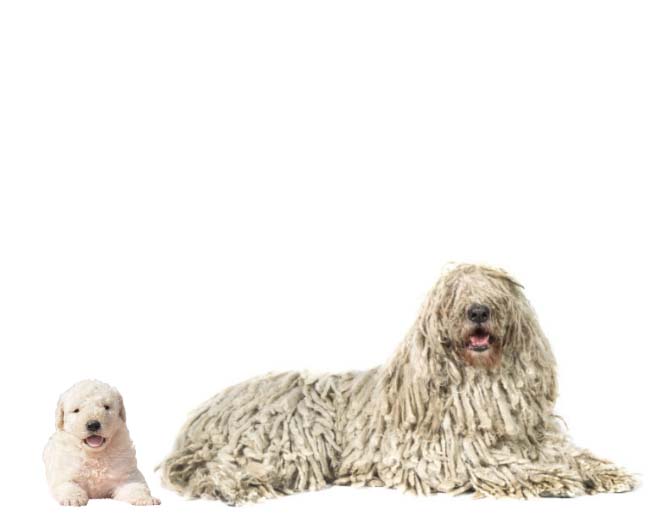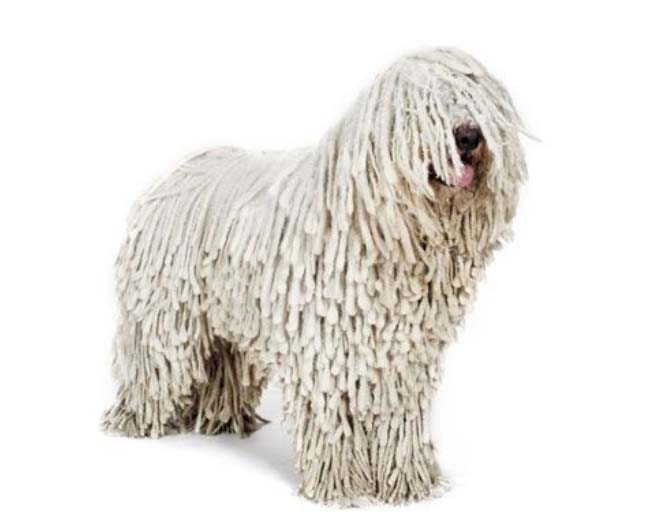We've gone Pink to help fight Breast Cancer.
Use code "BREAST" and we'll Donate $50 to National Breast Cancer Foundation
Main Menu
Petsy Breed Pages
The world’s most comprehensive information on the ...

$800.00 - $1500.00
Hungarian Commonmop Hungarian Sheepdog Mop Dog
Large
Working Group
Long
Extra high
Medium
10 to 12 years

Would you like to know what it would cost to insure an Komondor? Find out by getting a free quote, with petsy pet insurance.








Komondor come in a variety of colours, including White, White.


How much do
Komondor eat?
2.00 to 3.00 cups of food a day

How much
exercise do they need?
20 to 40 Mins

Are they kid friendly? They are affectionate dogs and are kid-friendly, although very young children aren't ideal.

Do they need a lot of space? They need space, a large garden or a home in the countryside. They are not lap dogs but working dogs. They may think of their family as their herd to take care of
Patellar Luxation
Legg-Perthes Disease
Hip Dysplasia
Heart murmurs
Komondor must have at least 3 to 4 cups of high-quality dried food a day, split into two meals; it is the recommended daily number. Although the dog needs to eat enough food to sustain a good weight, they should not be overfed. Clean, fresh water should be made available at all times.
The Komondor has a dense, soft, woolly undercoat and a coarse outer coat that is wavy or curly that sheds moderately. The cords should also be maintained weekly by brushing and occasional baths.
Regular trimming and professional grooming are also required.
Komondor requires a brush at least once or twice a week of a brush. Their nails should be kept short as long nails can cause discomfort and difficulties walking and running. Nails should be trimmed regularly because overly long nails can cause them pain and problems when walking and running.
To make sure that your dog is flea-free, schedule professional grooming regularly. This will keep them happy and in good health and will help your Komondor thrive.
Komondor needs a moderate amount of exercise. They enjoy a stroll to the park twice to thrice a day. Free-running will also work for them in a fenced yard. They love playing with other dogs as well, so it is ideal for bringing them to the park with familiar dogs so they don't get wary of each other.
Regular visits to their vet, 1-2 times a year, will ensure your Komondor is healthy and happy throughout all life stages. Veterinary care is essential to maintain a dog's health and well-being. The frequency of vet visits required will depend on the individual dog ?schedule at least twice a year veterinary care or as recommended.
Routine checkups will provide a chance to track your dog's growth and development, discuss any concerns with your vet, and forms a key part of preventative care.
The Komondor is a good family dog, especially because they are protective and affectionate to everyone. They do well with children, provided that they are properly socialized and introduced well at an early age. They can be wary of strangers sometimes, but they are generally gentle. They can make a great family companion and guard dogs.
Komondors are intelligent and can easily pick up their lessons. They tend to do things on their own, so training them will need a little understanding and patience. It is advisable to have creative and fun training to keep them motivated in participating in the training.
And because of their size and power, they need to have obedience training to teach them how to behave properly.
Komondors are affectionate dogs who are likely to get along well with domestic pets. They are very protective, which is why they don't like pets who are crossing their yard.
But generally, they are gentle to everyone, especially when properly socialized and introduced at an early age to encourage good behaviour.
Here are some of the breeders who we work with as part of our breeder awareness program.
They are invested in ensuring the longevity of the breed and that new owner become responsible Affenpinchers owners.
Affenpinchers who are friends of Petsy





Enter your email in the form below and we will send you the full report as a pdf directly to your inbox.
Don’t worry, we hate spam too – read our privacy policy
Find the right level of insurance for your needs our customised quote takes less than a few minutes to complete.
Komondor must have at least 3 to 4 cups of high-quality dried food a day, split into two meals; it is the recommended daily number. Although the dog needs to eat enough food to sustain a good weight, they should not be overfed. Clean, fresh water should be made available at all times.
Komondor needs a moderate amount of exercise. They enjoy a stroll to the park twice to thrice a day. Free-running will also work for them in a fenced yard. They love playing with other dogs as well, so it is ideal for bringing them to the park with familiar dogs so they don't get wary of each other.
The Komondor is a good family dog, especially because they are protective and affectionate to everyone. They do well with children, provided that they are properly socialized and introduced well at an early age. They can be wary of strangers sometimes, but they are generally gentle. They can make a great family companion and guard dogs.
Komondors are affectionate dogs who are likely to get along well with domestic pets. They are very protective, which is why they don't like pets who are crossing their yard.
But generally, they are gentle to everyone, especially when properly socialized and introduced at an early age to encourage good behaviour.
Suite 58, Mezzanine/388 George St, Sydney NSW 2000
Petsy Pty Ltd (ABN 54 633 343 058, AR 1277359) (‘Petsy’) distributes and promotes Petsy Pet Protection Plus (formally Petsy Pet Insurance), Petsy Puppy Protection Plus and Petsy Kitten Protection Plus as an authorised representative of Knose Financial Services Pty Ltd (ABN 38 620 795 735, AFSL 536651) trading as ThePetInsuranceCompany.com.au (‘ThePetInsuranceCompany.com.au’). ThePetInsuranceCompany.com.au is an underwriting agency acting under a binding authority as an agent for the insurer; Pacific International Insurance Pty Limited (ABN 83 169 311 193) (‘Pacific) in relation to Petsy Puppy Protection Plus and Petsy Kitten Protection Plus policies and Petsy Pet Protection Plus policies from 01 March 2023 or have an anniversary renewal date from 18 March 2023, and the Australia branch of Allied World Assurance Company, Ltd (ABN 54 163 304 907) (‘Allied World’) in relation to Petsy Pet Insurance policies purchased between 17 February 2022 and 28 February 2023 (inclusive) or renewed between 01 March 2023 and 17 March 2023 (inclusive). In all aspects of arranging this product, Petsy and ThePetInsuranceCompany.com.au act as an agent of Pacific/Allied World (as the case may be) and not as your agent. Any advice contained in this email is general advice only and has been prepared without taking into account individual objectives, financial situation or needs and you should consider the appropriateness of any such advice, the Product Disclosure Statement (‘PDS’) and the Target Market Determination (‘TMD’) available via http://www.petsy.com.au or by calling 1300 952 790 before making a decision to acquire, or to continue to hold, the product. Terms, conditions, limits and exclusions apply. Please refer to the PDS.
© Copyright 2024 Petsy Pet Insurance
During the application process You will be provided with the option to include Optional Extra Benefits that cover certain conditions and Treatments which are not otherwise covered under the Policy.
The Optional Extra Benefits are:
Alternative Therapies, Behavioural Problems, and Dental Illness.
Examples of Alternative Therapies: Acupuncture, physiotherapy, hydrotherapy
Examples of Behavioural Problems: Excessive licking, fur pulling, pacing and destructive
chewing.
Examples of Dental Illnesses: Dental diseases, gingivitis, periodontal disease.